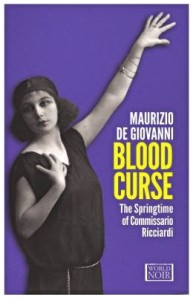“[Ricciardi] had learned that death by natural causes…left no lingering footprints …heading off down the road bearing its load…But that’s not how violent death worked; it didn’t have time. It had to leave in a hurry. In those cases, death staged a show, offering up the portrayal of the final pain and grief to [Ricciardi]…The [dead] left messages that Ricciardi gathered, listening to [their] last, obsessively repeated thought.”
 Baron Luigi Alfredo Ricciardi di Malomonte, Commissario of Public Safety at the Royal Police Headquarters in Naples, is a lonely man. Growing up as the orphaned child of a wealthy family, he has been living with his Tata Rosa ever since. Now in her seventies, she is “a bossy, indelicate, nitpicking ballbuster, a lousy cook with a rotten personality. But she’s all the family I have,” he comments. With a natural shyness that is close to terror when it comes to women, the thirty-year-old Ricciardi’s only real “friend” is his deputy, Brigadier Raffaele Maione, in whom he confides nothing about his private life. With his life secure because of his wealth, Ricciardi does not fear losing his job, and he often goes his own way in investigations if he feels justice will be better served. He has little fear of his department’s higher-ups, most of whom walk a fine line to avoid embarrassing government officials who, in 1931, are closely associated with Mussolini and his Fascists.
Baron Luigi Alfredo Ricciardi di Malomonte, Commissario of Public Safety at the Royal Police Headquarters in Naples, is a lonely man. Growing up as the orphaned child of a wealthy family, he has been living with his Tata Rosa ever since. Now in her seventies, she is “a bossy, indelicate, nitpicking ballbuster, a lousy cook with a rotten personality. But she’s all the family I have,” he comments. With a natural shyness that is close to terror when it comes to women, the thirty-year-old Ricciardi’s only real “friend” is his deputy, Brigadier Raffaele Maione, in whom he confides nothing about his private life. With his life secure because of his wealth, Ricciardi does not fear losing his job, and he often goes his own way in investigations if he feels justice will be better served. He has little fear of his department’s higher-ups, most of whom walk a fine line to avoid embarrassing government officials who, in 1931, are closely associated with Mussolini and his Fascists.
 Part of Ricciardi’s professional success comes from his unique ability to tap into the final thoughts of a victim of violent death. He has learned that if he appears at the scene of a crime and communes with the victim for just a brief period of time, he is able to hear the victim’s final thought, an experience he refers to privately as The Incident, or The Deed. This thought is always a victim’s concern about some aspect of his waning life, some unfinished business – often a message s/he is impelled to leave behind before departing from the earth.
Part of Ricciardi’s professional success comes from his unique ability to tap into the final thoughts of a victim of violent death. He has learned that if he appears at the scene of a crime and communes with the victim for just a brief period of time, he is able to hear the victim’s final thought, an experience he refers to privately as The Incident, or The Deed. This thought is always a victim’s concern about some aspect of his waning life, some unfinished business – often a message s/he is impelled to leave behind before departing from the earth.
This seemingly fantastic premise allows author Maurizio de Giovanni to take his mystery novels in new and unusual directions, while instantly involving the reader in the murder investigation. As the author explores, first, the victim and his/her life, and then the lives of the various suspects, he develops a character-based plot quite different from traditional noir mysteries in which more intricate plots develop from complex external events, often with sociopolitical roots. This novel has plenty of action and a full complement of bloody scenes, but here, the plot develops from the complexities of his characters and their personal interactions, rather than from larger, external crises.
Set in 1931 in the Sanita area of Naples, an area in which many families are eking out a living through long hours of work at service jobs, the novel introduces a series of characters whose lives further develop during the novel but do not always intersect, their stories moving along separately but with occasional connections to Ricciardi and Maione. Among the characters the reader meets at the outset are: Tonino Iodice, formerly a pizzaolo with a pushcart, now the owner of an unsuccessful pizza restaurant; Filomena Russo, an honorable woman who has been branded a “whore” in the neighborhood; Emma Serra di Arpaja, a wealthy woman who despises her older husband, Ruggero; Rituccia, a young girl abused by her father; Attilio, a handsome actor who is hoping for success; Enrica, a young woman who spends her evenings alone with her embroidery; and Carmela Calise, a woman with a large clientele for her fortune-telling business, and a smaller clientele for her personal loan business. Numerous secondary characters help to flesh out the stories of the major characters by showing them in action, and providing information to Commissario Ricciardi and Brigadier Maione, who has some personal problems of his own.

When Ricciardi agrees to meet someone at a cafe in the morning, he surprises the person by ordering the sfogliatelle, “little lobster tails,” thin layers of pastry with cream filling.
By the time Ricciardi is called to investigate the gory murder of Carmela Calise, the fortune teller and money lender, Maione has already started to investigate the slashing and disfiguring of the beautiful Filomena Russo, who refuses to tell who did this to her. Many people had reason to kill Carmela, but this is a particularly brutal killing, as is Filomena’s slashing. Several people come under immediate suspicion of the murder, but when Ricciardi visits the scene to “listen” to the words of the victim, he hears something which provides few clues: “God Almighty’s not a shopkeeper who pays His debts on Saturday.” As Ricciardi investigates, the case becomes broader, and he finds himself challenging his superiors.
As the other characters develop, so, too, do Ricciardi and Maione, who begin to feel the magic of spring: “[Spring] danced on tiptoe; it pirouetted daintily, still young, full of joy, not yet aware of what it would bring, but eager to mix things up a bit. Without any ulterior motives; just for the fun of shuffling the cards. And stirring people’s blood.” Ricciardi begins to yearn for a woman, and Maione finds himself yearning for two.
De Giovanni’s gift for description applies equally to his lyrical passages about the beauty of spring and the horrors of a murder scene, but it is his ability to show his characters in scenes which reveal their unique personalities which make this novel stand out. Some characters seem to have been included strictly for comic relief. One, the wife of a merchant, never appears or has a word of dialogue but is impossible to forget: “a homely monster with a mustache a few hairs short of [her husband’s] but a fuller beard, a woman who was impossible to look at even from a distance…” Another minor character provides wry humor which also reveals aspects of Neapolitan family life: The man, sixty years old, has been engaged to marry his sixty-two-year-old fiancée for forty years. They cannot marry because his eighty-seven-year-old mother still opposes the marriage.
In this second of his Ricciardi novels, which take place in different seasons, de Giovanni further develops both Ricciardi and Maione. His prize-winning first novel, I Will Have Vengeance, takes place in winter. Here in the spring of his second novel, both men begin to come alive much more fully, as the vibrant and often violent life of Naples unfolds on several levels. I can hardly wait to see what de Giovanni has in store for Ricciardi and Maione in his third novel, which should be set during a hot summer.
ALSO by de Giovanni (Inspector Ricciardi series): I WILL HAVE VENGEANCE (#1), EVERYONE IN THEIR PLACE (#3) THE DAY OF THE DEAD (#4), BY MY HAND (#5), VIPER (#6), THE BOTTOM OF YOUR HEART (#7), GLASS SOULS: MOTHS FOR COMMISSARIO RICCIARDI (#8) , NAMELESS SERENADE (9)
Inspector Lojacono series: THE CROCODILE (1), THE BASTARDS OF PIZZOFALCONE (2), DARKNESS FOR THE BASTARDS OF PIZZOFALCONE (#3), COLD FOR THE BASTARDS OF PIZZOFALCONE (#4), PUPPIES (#5)
Photos, in order: The author’s photo is from http://www.agoratv.it
The photo of Mussolini speaking from the balcony of the Palazzo Venezia appears on http://www.thehistoryblog.com That site also has a fascinating video of the recent discovery of a nine-room secret bunker for Mussolini, which is being readied for public visits.
Sfogliatelle, “little lobster tails,” are thin layers of pastry in rolls which are then filled with cream filling, not an ordinary early morning treat. http://freshlymadeeveryday.com
The Sanita neighborhood of Naples is depicted here in a photo by luiginardullo. See: http://www.panoramio.com/photo/23917616
ARC: Europa Editions


